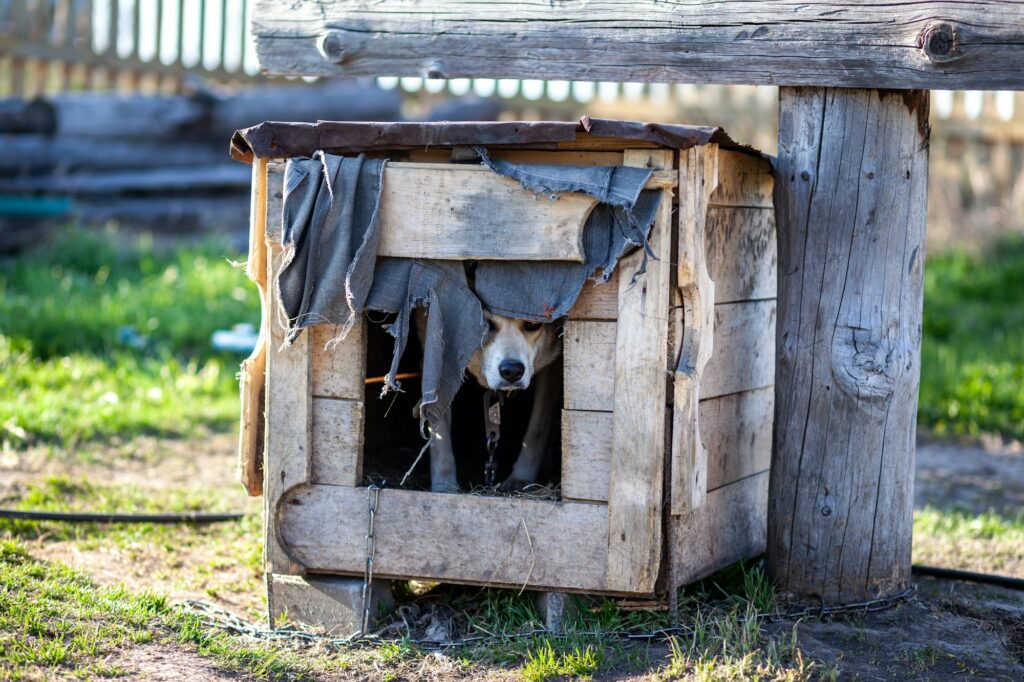Animal abuse in Maryland is a significant and widespread problem that mirrors the global issue. It is extremely important to understand the different types of animal abuse and mistreatment that animals can experience, from neglect to physical harm and even organized crimes like dog fighting. By recognizing the indicators of animal abuse and familiarizing ourselves with Maryland’s specific animal abuse laws, we can collectively help combat this appalling crime and champion animal rights.
What Exactly is Animal Abuse in Maryland?
Animal abuse in Maryland, like in many other places, refers to any act that causes unnecessary pain, suffering, or distress to animals. This can range from neglect, such as not providing adequate food, water, or shelter, to intentional acts of violence. It can also include organized activities such as dog fighting. Despite stringent laws against such actions, animal abuse remains a significant issue in Maryland, highlighting the importance of public awareness and action.
The Different Types of Animal Abuse
Understanding the different forms of animal abuse is critical to recognizing and preventing it. Animal abuse is not limited to physical harm; it encompasses a wide range of actions that cause harm or distress to animals. Let’s dive into the various types of animal abuse in Maryland.
Inadequate Shelter

Inadequate shelter is a common form of animal abuse that involves not providing appropriate living conditions for animals. This can include leaving animals exposed to harsh weather conditions without proper shelter or keeping them in overcrowded or unsanitary environments.
In Maryland, pet owners are required by law to provide their pets with suitable shelter that protects them from extreme weather conditions. However, enforcement can be challenging, and many animals suffer from inadequate shelter.
Beating and Physical Abuse
Beating and physical abuse are horrific forms of animal abuse in Maryland that are unfortunately highly prevalent. This category encompasses any action that causes bodily harm to an animal. It includes but is not limited to, striking animals with hands or objects, kicking, and other forms of violent contact.
Physical abuse is not always evident at first glance. It can range from visible external injuries, such as cuts, bruises, or limping, to less noticeable internal injuries, such as broken bones or internal bleeding. Furthermore, physical abuse often leads to psychological trauma, which can manifest in the form of fear, anxiety, and other behavioral changes in the animal. Beating and physical abuse can cause immediate pain and suffering, resulting in visible wounds or even crippled limbs. And in more severe cases, it can lead to long-term health problems like organ damage, chronic pain, or irreversible physical impairment. In the worst instances, physical abuse can result in the death of the animal.
Physical abuse is not only morally reprehensible but also illegal. Every member of the community needs to report any suspected cases to local authorities immediately. Timely reporting can ensure the protection of the animals and can help hold the abusers accountable for their actions, serving as a deterrent to others.
Dogfighting
Dogfighting is another appalling form of animal abuse in Maryland that unfortunately still occurs. This involves the brutal act of forcing two dogs to fight each other for the cruel entertainment of spectators, often involving gambling. These fights are incredibly violent and can result in severe injuries or even death for the dogs involved. Dogs used in these fights often suffer from neglect and abuse outside of the fights as well, being kept in deplorable conditions with minimal care. Dogfighting is not only inhumane and cruel but also illegal in all 50 states, including Maryland. Any suspicions of dogfighting activities should be reported to local authorities immediately to rescue the dogs involved and bring the perpetrators to justice.
Animal Hoarding
Animal hoarding is another form of animal abuse in Maryland that often goes unnoticed as it usually happens behind closed doors. This involves keeping an excessive number of animals without providing them the necessary care and attention they need. Animal hoarders often lack the resources and capacity to adequately feed, shelter, and provide medical care for all their animals. This results in the animals living in cramped and unsanitary conditions, often leading to disease, malnutrition, and sometimes death. It’s important to recognize that animal hoarding isn’t merely about the number of animals involved but more about the inability to provide proper care, which leads to suffering. If suspected, it should be reported to local authorities immediately as a severe form of animal abuse in Maryland.
Neglect
Neglect is an extremely common form of animal abuse, and it is a significant issue in Maryland. It involves failing to provide basic needs such as adequate food, water, shelter, and medical care. Neglected animals often suffer from malnutrition, dehydration, parasites, and a host of other health problems resulting from their unsanitary living conditions.

Neglect can also take the form of failing to provide animals with necessary medical care when they are sick or injured, leading to prolonged suffering. This form of animal abuse in Maryland can be challenging to identify because it often happens over a long period, and the signs may not be immediately visible. However, it is equally significant and damaging as other forms of animal abuse, and it is important for everyone to recognize and report any instances of neglect.
Signs of Animal Abuse in Maryland
Understanding the different types of animal abuse isn’t the only important aspect of combatting the issue. Recognizing the signs of animal abuse in Maryland is also extremely important. Animal abuse often goes unnoticed due to a lack of awareness about the different signs that an animal is being mistreated. It’s important to understand that these signs can be physical, behavioral, or environmental. Let’s delve into each of these categories to better equip ourselves with the knowledge to identify and report any indications of animal abuse.
Physical Signs
Physical signs are often the most visible indicators of animal abuse in Maryland. These can include noticeable wounds, scars, or signs of neglect, such as extreme thinness or missing fur. It’s important to pay attention to patterns of injury or recurring wounds, as these can often indicate ongoing abuse. Animals may also exhibit signs of improper care, such as overgrown nails, matted fur, or flea infestation. Additionally, animals who are being abused may show signs of physical discomfort or pain, such as limping or difficulty moving. It’s crucial to stay vigilant for these signs as they are often our first clue to intervene and potentially save an animal from ongoing abuse.
Behavioral Signs
Behavioral signs of animal abuse in Maryland can be quite varied. Abused animals might show signs of fear or aggression, especially when approached by humans. They may appear unusually skittish or shy, even attempting to hide or flee when approached. Some animals may show signs of separation anxiety, becoming distressed when left alone. Changes in eating habits can also be a sign of abuse, such as a sudden loss of appetite or rapid weight loss. Additionally, abused animals may display repetitive or compulsive behaviors, such as excessive licking or scratching. It’s important to note that while these behaviors can indicate abuse, they can also be signs of other issues, so it’s crucial to seek professional advice if you notice these or any other unusual behaviors in an animal.
Environmental Signs
Environmental signs of animal abuse in Maryland can be observed in the animal’s living conditions. These may include dirty or unsanitary living conditions, lack of appropriate shelter, or overcrowded living spaces. Animals that are kept in spaces littered with feces, garbage, or stale food are likely to be neglected. Similarly, animals that are consistently left alone without access to clean water or are tethered for extended periods are also signs of abuse. Lack of veterinary care, such as animals with visibly untreated wounds or illnesses, is another environmental sign of abuse. Being aware of these signs in an animal’s environment can play a crucial role in identifying and reporting animal abuse in Maryland.
Specific Laws Surrounding Animal Abuse in Maryland
To effectively combat animal abuse in Maryland, it is crucial to understand the legal framework that defines and punishes such acts. Maryland has specific laws in place to protect animals from various types of abuse and neglect. These laws cover a wide range of situations, including leaving pets unattended, abandonment, harmful procedures, and participation in dog fighting, among others. By familiarizing ourselves with these laws, we can better understand our legal responsibilities towards animals and how to act when these laws are violated.
Unattended and Tethered Dogs
In Maryland, dog owners can face misdemeanor charges if their dogs are left chained or tethered outdoors under certain conditions. These conditions include limiting the dog’s movement excessively, not providing access to clean water or proper shelter, maintaining unsafe or unclean environments, using a too-small or predominantly metal collar, or if the dog sustains injuries due to being restrained. Further, leaving a dog unattended outdoors for more than 30 minutes without adequate shelter or shade is illegal, especially during extreme weather or when temperatures exceed 90 degrees.
Abandonment of Domestic Animals

In an effort to combat animal abuse in Maryland, the state has established that it is a misdemeanor for animal owners or custodians to abandon their animals. This includes leaving them on the road, in any other public place, or on private property with the intention of no longer caring for them.
This law underscores the responsibility of pet ownership and the commitment it entails, serving as a deterrent to those who might consider abandoning their pets without regard for their well-being.
Leaving Pets in Cars
In Maryland, pet owners are prohibited from leaving their dogs or cats unattended in vehicles in a manner that poses a risk to their health or safety. Violation of this rule could lead to charges of animal abuse or neglect. Specific rescue personnel, including animal control and humane society officers, are authorized to employ reasonable force to rescue a dog or cat in danger from a locked vehicle.
Poisoning Dogs
In Maryland, the law takes a stern stance against the harmful and cruel act of poisoning dogs. It is considered a misdemeanor to maliciously give a dog poison or ground glass or to leave out such harmful substances where a dog could eat them. This law underscores the gravity of such an inhumane act and serves as a deterrent to those who might consider harming animals in this way. Violations can lead to serious legal consequences, reinforcing the importance of treating all animals with the care and respect they deserve.
Ear Cropping, Tail Docking, and Other Procedures
In Maryland, it is a criminal offense for anyone other than a licensed veterinarian to carry out specific procedures on a dog. These procedures include ear cropping, tail docking, and removing a dewclaw. The state also prohibits the severing of a dog or cat’s vocal cords or larynx, a process known as “devocalization,” and the declawing of cats unless these procedures are medically necessary and are performed by a licensed vet.
It is extremely important to note that ear cropping, tail docking, and dewclaw removal are considered cruel procedures due to the unnecessary pain and distress they cause to animals. Even when performed by a licensed veterinarian, these procedures are typically carried out for cosmetic or breed standard reasons rather than for the health or benefit of the animal. They involve the removal or alteration of healthy body parts, often without adequate pain management, leading to discomfort, pain, and potential complications. Furthermore, these procedures can have lasting psychological impacts, as they involve the removal of body parts that dogs use for communication and balance. Therefore, many animal rights advocates and professionals argue against these practices, emphasizing the need for laws protecting animals from unnecessary and harmful procedures.
Dogfighting Laws
Involvement in organized dogfighting is one of the most severe forms of animal abuse in Maryland. Owning or training the animals and even arranging the fights is considered a felony. Even spectating such a horrific event is regarded as a misdemeanor. A felony conviction for dogfighting is classified under animal cruelty, and all the additional penalties related to animal cruelty apply. These stringent laws serve to deter individuals from participating in or contributing to this inhumane activity.
Help Us Combat Animal Abuse in Maryland
Combating animal abuse in Maryland is a collective responsibility. We all play a crucial role in recognizing the signs of abuse, understanding the laws, and taking action. Your help is invaluable in this fight against animal cruelty. You can make a significant impact by staying vigilant, reporting suspected abuse, and promoting awareness within your community. Together, we can create a safer and more compassionate Maryland for all animals.
